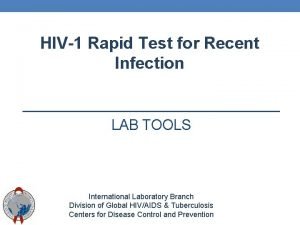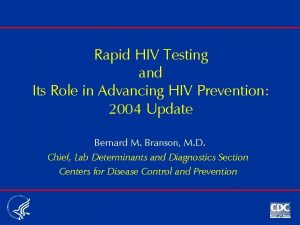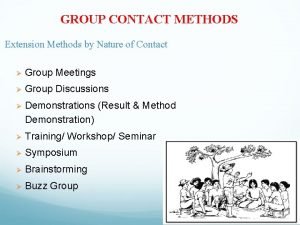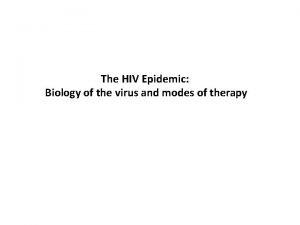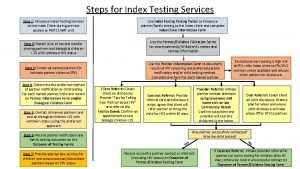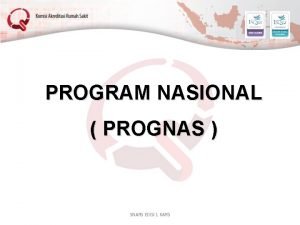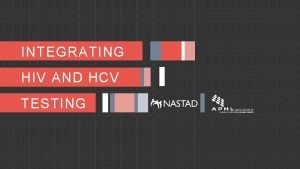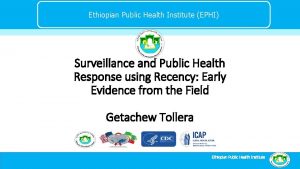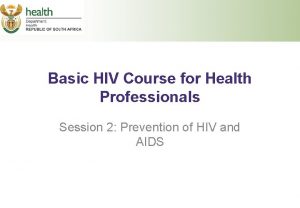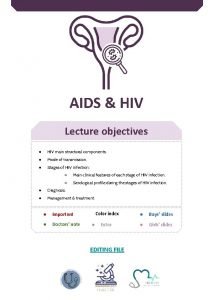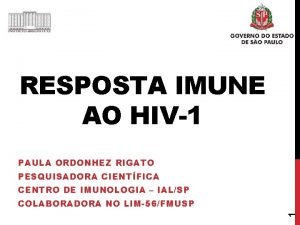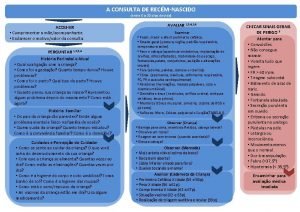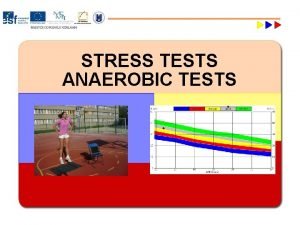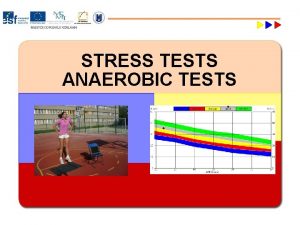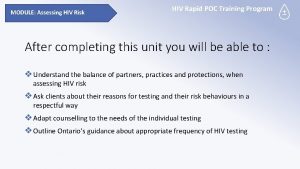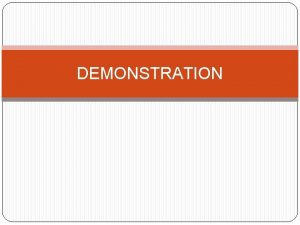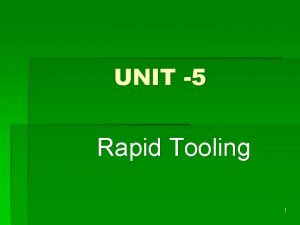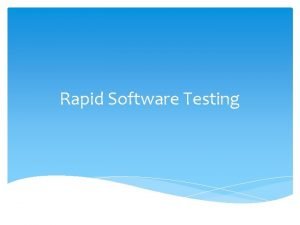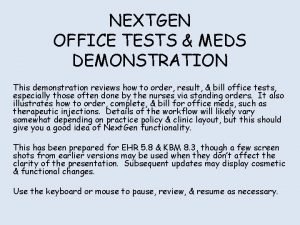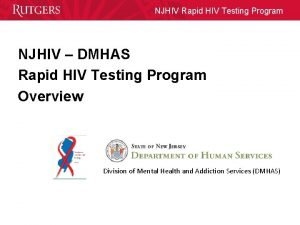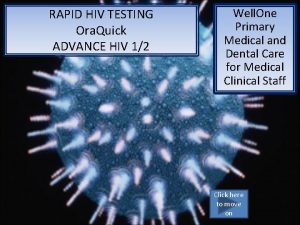Module 9 Performing HIV Rapid Tests Demonstration and


















































- Slides: 50

Module 9: Performing HIV Rapid Tests Demonstration and Practice

Learning Objectives At the end of this module, you will be able to: • Perform 3 HIV rapid tests according to SOP • • • Insert Test 1 name Insert Test 2 name Insert Test 3 name Perform multiple tests simultaneously Accurately interpret individual test results Accurately determine HIV status 2 Lab workers Health workers Counselors

Content Overview of Testing Procedures A Workspace Setup B Demo + Practice (individual tests on known samples) B A Video Presentation and Discussion B Practice (Multi-test algorithm with blind samples) A dry room Optional hands-on session B practical room 3 Lab workers Health workers Counselors

Capillus 4 Lab workers Health workers Counselors

Capillus: Getting Ready 1. Collect test items and other necessary lab supplies 2. Label the device with client identification number 3. Place slide on the black interpretation card. Ensure that slide is right side up. 5 Lab workers Health workers Counselors

Capillus: Reagent Preparation 4. Gently mix the latex reagent well ensuring that it is homogenous 5. Use the dropper to draw the latex reagent up to the calibration mark. Avoid drawing up air bubbles. 6. Dispense the reagent into the mixing well, away from the capillary channel. Do not allow the dropper to touch the slide. 6 Lab workers Health workers Counselors

Capillus: Collecting Specimen 7. Collect 10 µl of specimen using a new disposable pipette tip with the pre-calibrated pipette. 7 Lab workers Health workers Counselors

Capillus: Applying Specimen to Test Slide 8. Hold the pipette directly over the well and dispense the specimen directly into the latex solution 9. Mix the specimen and latex by gently pumping the mixture in and out of the tip 3 times. Stir in a circular motion at least 5 times. 10. Initiate the capillary flow by moving the mixture to the opening of the channel using the pipette. 8 Lab workers Health workers Counselors

Capillus: Getting Results 11. Allow the latex mixture to flow through the entire channel and into the viewing window (about 3 -7 min. ) before reading the results. 12. Read and record the results and other pertinent info on the worksheet. 9 Lab workers Health workers Counselors

Capillus – Test Interpretation Nonreactive Reactive 10 Lab workers Health workers Counselors

Determine 11 Lab workers Health workers Counselors

Determine: Getting Ready 1. Collect test items and other necessary lab supplies 2. Use 1 strip per test and be sure to preserve the lot number on the remaining packet of strips 3. Label the test strip with client identification number 4. Pull off the protective foil cover 12 Lab workers Health workers Counselors

Determine: Collecting Specimen 5. Collect 50 µl of specimen using a precision pipette or 1 drop using a plastic transfer pipette 13 Lab workers Health workers Counselors

Determine: Applying Specimen and Buffer to Test Strip 6. Apply the specimen to the absorbent pad on the strip 7. For whole blood only add 1 drop of chase buffer to the specimen pad 14 Lab workers Health workers Counselors

Determine: Getting Results 8. Wait 15 minutes (no longer than 60 minutes) before reading the results 9. Read and record the results and other pertinent info on the worksheet 15 Lab workers Health workers Counselors

Determine - Test Interpretation Reactive Non-reactive Invalid 16 Lab workers Health workers Counselors

Hema-Strip 17 Lab workers Health workers Counselors

Hema-Strip: Getting Ready 1. Collect test items and other necessary lab supplies 2. Label device with the client identification number 18 Lab workers Health workers Counselors

Hema-Strip: Collecting Specimen 3. Collect specimen directly from the finger-stick. Touch specimen with device tip until tip is full. 19 Lab workers Health workers Counselors

Hema-Strip: Buffer Preparation 4. Remove buffer vial – separate from top of device 5. Place buffer vial on a flat surface 20 Lab workers Health workers Counselors

Hema-Strip: Applying Specimen and Buffer to Test Strip 6. Firmly press the device tip through the foil cover. Continue pushing device, usually 2 more times, to the bottom of vial until device and buffer vial snap together tightly. 7. Place the test device upright in a rack 21 Lab workers Health workers Counselors

Hema-Strip: Getting Results 8. Wait 15 minutes before reading the results 9. Read and record the results and other pertinent info on the worksheet 22 Lab workers Health workers Counselors

Hema-Strip: Test Interpretation Reactive Non-reactive Invalid 23 Lab workers Health workers Counselors

Ora. Quick 24 Lab workers Health workers Counselors

Ora. Quick: Getting Ready 1. Collect test items and other necessary lab supplies 2. Set reusable stand on a flat, level surface. Partially remove device from package and label device and the developer vial with client identification number. 3. Carefully uncap the developer vial and place vial into the stand 25 Lab workers Health workers Counselors

Ora. Quick: Collecting Specimen (Blood or Oral Fluids) 4. Collect approximately 5 µl of specimen using a new disposable loop 4. Instruct the client to use the pad end of the test device to swab completely across the outside of the upper and lower gums, one time around 26 Lab workers Health workers Counselors

Ora. Quick: Transferring Specimen (Blood Only) 5. Transfer the collected specimen to the vial 6. Stir the specimen in the vial with t he loop 27 Lab workers Health workers Counselors

Ora. Quick: Inserting Test Device Into Buffer Vial 7. Insert the device pad completely into the vial with the result window facing forward 28 Lab workers Health workers Counselors

Ora. Quick: Getting Results 8. Wait 20 minutes (no longer than 40 min. ) before reading the results 9. Read and record the results and other pertinent info on the worksheet 29 Lab workers Health workers Counselors

Ora. Quick: Test Interpretation Reactive Non-reactive Invalid 30 Lab workers Health workers Counselors

Uni-Gold 31 Lab workers Health workers Counselors

Uni-Gold: Getting Ready 1. Collect test items and other necessary lab supplies 2. Remove device from package and label device with client identification number 32 Lab workers Health workers Counselors

Uni-Gold: Collecting Specimen 3. Collect specimen using the disposable pipette 33 Lab workers Health workers Counselors

Uni-Gold: Adding Specimen and Reagent to Test Device 4. Add 2 drops (approx. 60µl) of specimen to the sample port in the device 5. Add 2 drops (approx. 60µl) of the appropriate wash reagent to sample port 34 Lab workers Health workers Counselors

Uni-Gold: Getting Results 6. Wait for 10 minutes (no longer than 20 min. ) before reading the results 7. Read and record the results and other pertinent info on the worksheet 35 Lab workers Health workers Counselors

Uni-Gold: Test Interpretation Reactive Non-reactive Invalid 36 Lab workers Health workers Counselors

Activity: Workspace Setup Instructions: § Identify your Workspace in the practical room § Gather test kits and supplies § Obtain reactive and non-reactive specimens from instructor § Arrange all items at your work station Activity time: 10 minutes 37 Lab workers Health workers Counselors

Hands-On Practice: Individual Tests Instructions: • Use safety precautions • Practice with blood provided by your instructor only • Raise your hand if you need additional supplies • Show your test results to instructor after you are done Total time: 15 minutes per test 38 Lab workers Health workers Counselors

Video Presentation and Discussion 39 Lab workers Health workers Counselors

Video: Capillus Key learning points • What preparation is required for the test kit before testing? • What are the components in the test kit? • What are controls for? How do you use them? • What information needs to be recorded, and where? • How should you position the slide? Why do you place the slide on a black interpretation card? • How do you collect blood? What device do you use? • How long do you set the timer? • How many results are possible? How do you read them? 40 Lab workers Health workers Counselors

Video: Determine Key learning points • What preparation is required for the test kit before testing? • What are the components in the test kit? • What do you need to preserve when tearing test strip form the packet? • What information needs to be recorded, and where? • How do you collect blood? What device do you use? • Which step can you omit when using serum or plasma? • How long do you set the timer? • How many results are possible? How do you read them? 41 Lab workers Health workers Counselors

Video: Hema-Strip Key learning points • What preparation is required for the test kit before testing? • What are the components in the test kit? • When you open the test packet, what do you need to check? • What information needs to be recorded, and where? • How do you collect blood? What device do you use? • How long do you set the timer? • How many results are possible? How do you read them? 42 Lab workers Health workers Counselors

Video: Ora. Quick Key learning points • What preparation is required for the test kit before testing? • What are the components in the test kit? • What information needs to be recorded, and where? • How do you collect blood? What device do you use? • How do you collect oral fluids? What device do you use? • How long do you set the timer? • How many results are possible? How do you read them? 43 Lab workers Health workers Counselors

Video: Uni-Gold Key learning points • What preparation is required for the test kit before testing? • What are the components in the test kit? • What information needs to be recorded, and where? • How do you collect blood? What device do you use? • How long do you set the timer? • How many results are possible? How do you read them? 44 Lab workers Health workers Counselors

Video: Multiple HIV Tests Key learning points • What are the advantages of performing more than one test at a time? • Why must you keep two test kits separate when performing both at the same time? • Do you collect blood at the same time or separately when performing multiple tests? • How do you set the timer when two tests require different wait time? • When is a tie-breaker used? How does it determine HIV status? 45 Lab workers Health workers Counselors

Country Algorithm • Display approved country algorithm here 46 Lab workers Health workers Counselors

Possible Outcomes in a Parallel Algorithm TEST 1 TEST 2 TEST 3 HIV Status Non-reactive Negative Reactive Positive Non-reactive Reactive Non-reactive Negative Non-reactive Reactive Positive Reactive Non-reactive Reactive Positive 47 Lab workers Health workers Counselors

Hands-On Practice: Multi-Test Algorithm Conduct test 1 and test 2 simultaneously following the multi-test algorithm. Perform the algorithm using the 5 designated blind specimens and determine HIV status of each. Specimen 1 Test 1 - Test 2 - Test 3 HIV Status 2 Test 1 - Test 2 - Test 3 HIV Status 3 Test 1 - Test 2 - Test 3 HIV Status 4 Test 1 - Test 2 - Test 3 HIV Status 5 Test 1 - Test 2 - Test 3 HIV Status 48 Lab workers Health workers Counselors

Hands-On Practice: Multi-Test Algorithm (Cont’d) Instructions: • Collect supplies and obtain panel of blind specimens • Organize your workspace • Complete one algorithm before starting the next • Don’t forget – Use safety precautions • Practice on blood provided by your instructor only • Raise your hands if you need additional supplies • Record results on worksheet • Keep test devices - instructor will check results before discarding of devices Total time: 2 hours 49 Lab workers Health workers Counselors

Summary • Describe the key learning from performing: § § § (In-country test 1) (In-country test 2) (In-country test 3) • Describe the key learning from performing the multi-test algorithm 50 Lab workers Health workers Counselors
 Asante hiv-1 rapid recency assay
Asante hiv-1 rapid recency assay Hiv test
Hiv test Rapid extrication technique emt
Rapid extrication technique emt Ace different tests help iq but
Ace different tests help iq but C device module module 1
C device module module 1 A bacterial std that usually affects mucous membranes
A bacterial std that usually affects mucous membranes Chapter 24 sexually transmitted diseases and hiv/aids
Chapter 24 sexually transmitted diseases and hiv/aids Advantages and disadvantages of result demonstration
Advantages and disadvantages of result demonstration Presentation and demonstration in selling process
Presentation and demonstration in selling process Sales presentation and demonstration
Sales presentation and demonstration Ual harvard referencing
Ual harvard referencing Learning foundation and performing arts
Learning foundation and performing arts Health and safety in performing arts
Health and safety in performing arts Health and safety in performing arts
Health and safety in performing arts Plicatured nail treatment
Plicatured nail treatment Quang trung
Quang trung Where did hiv come from
Where did hiv come from Test wiedzy o hiv
Test wiedzy o hiv Hiv index testing steps
Hiv index testing steps Prognes
Prognes Phdp in hiv
Phdp in hiv Kuchecheudzwa
Kuchecheudzwa Hiv test window period
Hiv test window period Why do the bodys antibodies fail to protect people from hiv
Why do the bodys antibodies fail to protect people from hiv Iris hiv
Iris hiv Where did hiv come from
Where did hiv come from Hiv risk factors
Hiv risk factors Fiebig hiv
Fiebig hiv Hiv case-based surveillance in ethiopia
Hiv case-based surveillance in ethiopia Triệu chứng nhiễm hiv
Triệu chứng nhiễm hiv Basic hiv course
Basic hiv course Stakeholders in hiv prevention
Stakeholders in hiv prevention Hiv treatments
Hiv treatments Causative organism of hiv/aids
Causative organism of hiv/aids What does hiv stand
What does hiv stand Aids 101
Aids 101 Hiv test window period
Hiv test window period Hiv stool color
Hiv stool color Procentowe ryzyko zakażenia hiv
Procentowe ryzyko zakażenia hiv Tes klamidia di prodia
Tes klamidia di prodia Hiv lifecycle
Hiv lifecycle Hiv pencere dönemi
Hiv pencere dönemi Hiv lifecycle
Hiv lifecycle Hiv
Hiv Chapter 17 oral pathology
Chapter 17 oral pathology Incubation period of hiv
Incubation period of hiv Imune celular
Imune celular Vidas hiv duo ultra package insert
Vidas hiv duo ultra package insert Profilaksis pasca pajanan hiv
Profilaksis pasca pajanan hiv Bízom benned uram jézus
Bízom benned uram jézus Tabela perímetro cefálico por idade
Tabela perímetro cefálico por idade
